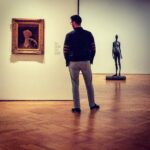By Reed V. Horth for ROBIN RILE FINE ART
I received a question in response to my blog post “Can Art Save the World” from a friend who asked: “Can the world save Art?”. I thought it was a great question, which I may try to expound on a bit further later, but here was the reply I sent to him….

“Whether or not the world can save art is up to the Artists to initiate. Perhaps the world will provide them enough perspective to distill in such a way as to bring us truths we would not find through alternate means. But, Art’s slow methodical march toward commercialism mirrors our own sound-byte culture. The world has affected Art so gravely due to the speed in which it operates… the fleeting windows of opportunity…the news-cycles that dictate that the accusation as news, not the verdict…. the mediocrity with which some people become famous.
With every artist touting their work as the second coming of Pablo Picasso, the talent pool is much more diluted. True talent can become despondent that it will never be located because the public cannot weed the wheat from the chaff.
Picasso was somewhat of a figurehead for artists that felt they could circumvent the classical apprenticeship methods, schooling, gestures, modeling. However, Picasso was classically trained (his father was an art teacher) and was mimicking masters from the time he could hold a pencil. At one point, his father declared “I will never paint again” as his infant son’s talents overtook his own. His life was filled with styles borrowed from others as he absorbed Van Gogh, Lautrec, Ingres, Delacroix, Velasquez. It was only when he saw primitive Iberian sculpture that he minimized his artwork into many of the forms which we now recognize him for. (ED NOTE: This theory, “The 10,000 Hour Rule”, is explored in the book “Outliers” by Malcolm Gladwell. Certainly worth the read) While in his 50’s, he visited an exhibit of children’s art and exclaimed, “I have worked my whole life to paint like them”.

Now, when taken as an oeuvre, Picasso’s work tells a reversed story of gradually discovering oneself going from complex to primitive. When taken piece by piece, many feel “I could do that”…. So many attempted. Picasso was able to break the rules because he knew the rules. So much so that he was able to create his own. Many artists feel that the old rules do not apply and they can skate by without learning the basics. And, truth be told… many artists do skate by. Our radio dials are filled with mediocre musicians with multi-million dollar contracts, our book shelves are flooded with second-rate writers, our televisions have marginal actors and shoddy craftsmanship merely because the media was available to them.

Many artists of all genres and vocations have turned their backs on history itself preferring to skip over all of the technical mumbo-jumbo and skip right to the money-making. However (to use a sports metaphor) this is akin to going straight from high school to the NBA. Certainly, some are naturally talented enough to make this transition (Kobe Bryant, LeBron James, Kevin Garnett) but not the vast majority who must mature in the college ranks, learn the game, the rules and nuances before becoming a Professional. It is an infinitesimally rare occurrence that one can succeed at anything through talent alone. Training, in some capacity, is a must.
When the world demands higher standards from it’s artists, the artists will adapt as they always have. However, if we as a world continue to reward mediocrity… perhaps we don’t bear saving.
Cheers, RV3″


